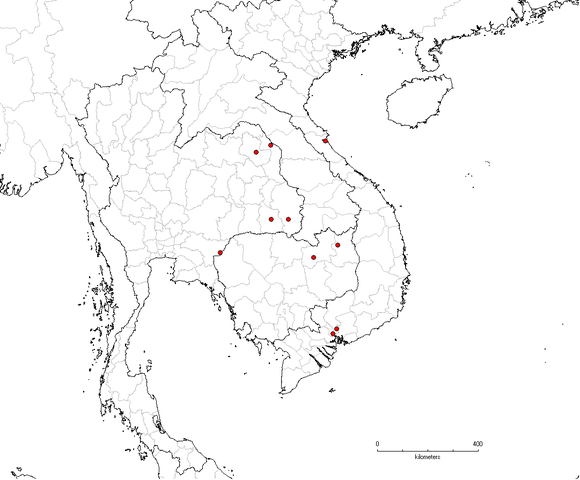Nomenclature
Accepted name/Authority/Place of publication:
Argyreia mekongensis Gagnep. & Courchet, Not. Syst. 3: 134. 1915.
Synonyms:
Lettsomia mekongensis (Gagnep. & Courchet) Kerr, Fl. Siam. 3(2): 34. 1954.
Description
Habit:
Woody twiner; stems 2–4 m long, appressed hairy.
Leaves:
Leaves elliptic to broadly oblong, 7–12 by 3–4 cm, tapering slightly toward both ends, base obtuse, apex acute, upper side sparsely strigose, underside densely greyish tawny pubescent; lateral veins 8–10 per side; petiole 0.8–1 cm, hairy.
Inflorescences:
Inflorescences axillary, 5–7-flowered, bracteose; peduncle 0.5–1 cm; bracts lanceolate or ovate-cuspidate, c. 2 by 0.8 cm, long acuminate, yellowish hispid outside, persistent, bracteoles similar; pedicels c. 10 mm.
Flowers:
Flower sepals unequal, 10–12 by 8–9 mm, outer 3 broadly elliptic, obtuse, inner obovate to spathulate, rounded, abaxially yellowish hispid, inner ones subglabrous; corolla campanulate, 5 cm and longer, white, limb 5-pointed, sparsely pilose outside; stamens included, filaments dilated and concave at insertion, papillose below, anthers oblong, c. 4 mm; pistil included, disc obscurely lobed, ovary c. 2.5 mm long, 2-celled, glabrous, jointed to style base.
Fruits:
Berry globose, 7–9 mm diam., tightly enclosed in calyx and bracts.
References:
Staples, G. & P. Traiperm. 2010. Argyreia in Convolvulaceae. Fl. Thailand 10(3): 337–371.
Biogeography, Ecology and Natural History
Distribution Map:

Distribution:
Thailand, Laos, Vietnam.
Ecology:
On roadsides,
margins of cleared land, open deciduous forest and secondary regrowth, over
silty and sandy soil; altitude: 50–130 m.
Phenology:
Flowering: June, August, September; fruiting: October, November.
References:
Staples, G. & P. Traiperm. 2010. Argyreia in Convolvulaceae. Fl. Thailand 10(3): 337–371.
Other information
Common names and uses:
Phung mu (Thai).
Authorship for webpage
Editor:
George Staples, Esmond Er
Contributors:

Classification:

Add new comment